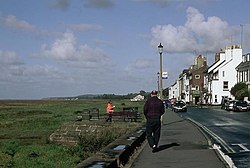Parkgate, Cheshire
| Parkgate | |
| Cheshire | |
|---|---|
 Parkgate, with salt marsh and quayside | |
| Location | |
| Grid reference: | SJ277782 |
| Location: | 53°17’46"N, 3°5’6"W |
| Data | |
| Population: | 3,591 (2011) |
| Post town: | Neston |
| Postcode: | CH64 |
| Dialling code: | 0151 |
| Local Government | |
| Council: | Cheshire West & Chester |
| Parliamentary constituency: |
Ellesmere Port and Neston |
Parkgate is a village on the Wirral Peninsula of Cheshire. It stands on the bank of the River Dee, adjoining forty square miles of salt marsh, separated by a sandstone former sea wall.
At the 2011 Census, Parkgate had a population of 3,591.
History
Parkgate was an important port from the start of the 18th century, in particular as an embarkation point for Ireland. The River Dee, which served as a shipping lane to the Roman city of Deva (Chester), had silted up, in part by 383 AD, creating a need for a port further downstream.[1] Quays were built, first at Burton and later near the small town of Neston, but further silting required yet another re-siting slightly further downstream near the gate of Neston's hunting park. Thus was the settlement of Parkgate born.


During the years when the port existed, two distinguished guests stayed in the local hostelries. One was Lord Nelson's mistress, (Lady) Emma Hamilton, who was born in nearby Ness and bathed at Parkgate, apparently as a cure for a skin complaint.[2] Another was George Frideric Handel. Contrary to often-repeated legend he did not stay in Parkgate before sailing to Dublin in November 1741 for the first performance of his Messiah (he travelled from Holyhead). However, he returned from Ireland via Parkgate in August 1742.[3]
As the Dee silted up even further, Parkgate became unusable as a port and was superseded by the port of Liverpool, on the nearby River Mersey.[4] Towards the end of the 18th century Parkgate was popular as a seaside resort with bathers, but this diminished as the sands of the estuary were consumed with grass. Sailing from Parkgate across the estuary to Bagillt was still possible in 1864, as there is report of an accident in which the landlord of the Pengwern Arms and his brother were drowned when trying to land in rough sea conditions – three others survived.[5] But as silting progressed, with no beach and no direct access to the sea, Parkgate could manage only small subsistence from fishing and shrimps. The silting of the Dee has been accelerated by the deliberate introduction of the invasive colonising grass Spartina anglica in Connah's Quay in 1928, resulting in the growth of extensive marshlands.[6][7]
Mostyn House School, a striking black-and-white building, was opened in Parkgate in 1855. From 1862 until it closed in 2010, it was run by the Grenfell family, most recently as an independent co-educational day school. Sir Wilfred Grenfell (1865–1940), famous medical missionary to Newfoundland and Labrador, was born in Parkgate and was a pupil at the school. The 6th Duke of Westminster's children attended Mostyn House, including his son the 7th Duke of Westminster. [8]
During the Second World War two of Parkgate's houses which both contained cellars were converted into shelters and used for public protection from the bombs. Small lights were placed on the marsh to trick the German bombers into thinking settlements were below.
After the war, Parkgate flourished as a highly desirable residential area. It became a conservation area in 1973.
The parish church, St Thomas' Church, reopened for worship in May 2010. Built in 1843, it had been closed since it was declared unsafe in 1994.[9]
About the village
An affluent village and still popular with tourists, it boasts birdwatching, regionally famous homemade ice cream, sunsets and fresh local seafood, including shrimps and cockles.
Birdwatchers also come at the spring tides at this time to watch the birds usually hidden in the grasses of the marshland: a popular location is the Old Baths site, to the north of the village, from which the marshes can be viewed from a parked vehicle.
The marshlands of Parkgate are currently managed by the RSPB as part of the Dee Estuary Nature Reserve.[10]
| ("Wikimedia Commons" has material about Parkgate, Cheshire) |
References
- ↑ DEVA VICTRIX / CASTRA LEGIONIS Roman Legionary Fortress & Settlement, www.Roman-Britain.org, http://www.roman-britain.org/places/deva.htm, retrieved 1 October 2010
- ↑ Cheshire Magazine: Lady Hamilton and Parkgate, C.C. Publishing, http://www.cheshiremagazine.com/Archives/hamilton.html, retrieved 26 July 2007
- ↑ Place, Geoffrey (1994). The Rise and Fall of Parkgate: Passenger Port for Ireland, 1686–1815. Manchester: Carnegie Publishing Ltd. p. 154. ISBN 1859360238.
- ↑ Historical information about the River Dee, The Proudman Oceanographic Laboratory, archived from the original on 12 March 2008, https://web.archive.org/web/20080312191659/http://www.pol.ac.uk/home/insight/dee.html, retrieved 26 July 2007
- ↑ "Another Melancholy Boat Accident". Oxford Journal: p. 6. 26 May 1864.
- ↑ Huckle, Jonathan Mark; Marrs, Robert H; Potter, Jacqueline. Characterising the salt-marsh resource using multi-spectral remote sensing. University of Chester Digital Repository. http://chesterrep.openrepository.com/cdr/bitstream/10034/76154/2/chapter%201.pdf. Retrieved 1 October 2010.
- ↑ Natures Calendar, Estuaries – Dee Estuary, BBC, https://www.bbc.co.uk/naturescalendar/autumn/estuaries/dee/dee_background.shtml, retrieved 1 October 2010
- ↑ James, Erwin (25 September 2012). "Edwina Grosvenor". Guardian (London). https://www.theguardian.com/society/2012/sep/25/lady-edwina-grosvenor-prison-reformer.
- ↑ Chester Diocesan News, July 2010
- ↑ "Dee Estuary – Parkgate". RSPB. http://www.rspb.org.uk/deeestuary.
